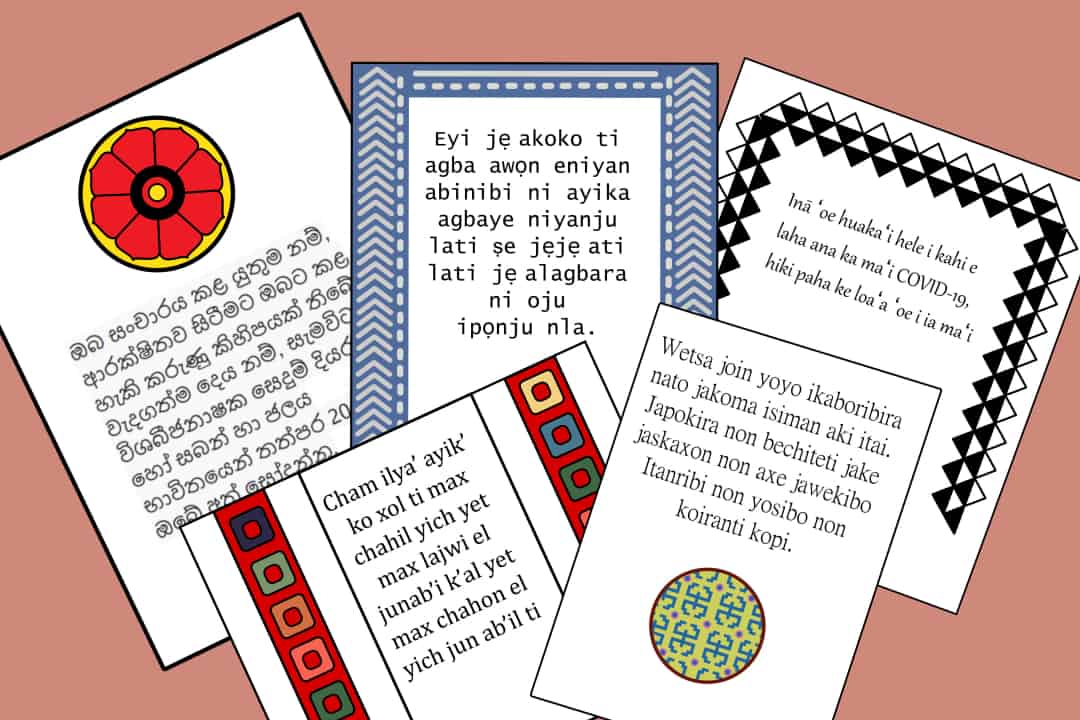During the months that the COVID-19 pandemic has taken grip over the entire world, many flaws within our institutions have been exposed — be they structural, medical, or judicial. One key issue is that information about the virus is largely inaccessible to many marginalized communities. Due to health care access disparities around the globe, COVID-19 poses an especially grave threat to Indigenous peoples.
Hoping to amend this and ensure that important information encompasses all languages and groups, Victor A. Lopez-Carmen, Sukhmeet Singh Sachal, Sterling Stutz, and Thilaxcy Yohathasan co-founded the Translations 4 Our Nations (TFON) initiative, which aims to translate documents related to COVID-19 awareness and prevention into Indigenous languages.
In a written interview with The Varsity, founder Lopez-Carmen and co-founders Sachal, Stutz, and Yohathasan emphasized the urgency driving this initiative.
Lopez-Carmen is a member of the Crow Creek Sioux Tribe and the Yaqui Tribe, and according to him, he will be the first physician in his tribe once he graduates from Harvard Medical School. He explained that accessibility was the main motivation for the inception of TFON.
“I founded this initiative because I saw how my own Indigenous communities struggled with lack of COVID-19 information that was in their language or culturally relevant to their contexts. The idea was to work directly with Indigenous community members in the spirit of partnership, and making sure the benefits went back to them and their communities.”
University of Toronto master’s student Yohathasan, a daughter of Tamil immigrants, wrote that her own background motivated her to join Lopez-Carmen’s project: “I joined this initiative to support the necessity of health communication documents being written into the languages you speak at home.”
She continued, “Growing up, it was difficult to bring documents that were not in basic English from school to my parents who did not understand much written English. The gap of translated COVID-19 documents is something that needs to be addressed quickly, to mitigate further negative health outcomes for communities that are unable to understand English.”
Sachal, a University of British Columbia medical student, echoed this sentiment, affirming that “people were being left behind due to language barriers.” He added that taking part in this initiative has been a rewarding accomplishment for him, as he is sure that “it is going to drastically help improve health literacy in Indigenous communities around the world.”
Stutz, a U of T master’s student, emphasized the inequality that can arise due to incomprehensive access to health information: “Many Indigenous scholars have written about the possibility for COVID-19 to exacerbate existing health disparities.” This is what motivated her to join the initiative after seeing a call for volunteers in the spring.
Stutz’s words are mirrored in the warning that Indigenous Services Minister Marc Miller gave on September 30 when he announced that Indigenous communities experienced an alarming increase in infected individuals in the month of September.
In an interview with the Canadian Press, Kluane Adamek, who was sworn in as the Yukon regional chief of the Assembly of the First Nations, asserted that “[Indigenous communities] need resources to support community-led, community-driven solutions.”
TFON’s medical content is created and reviewed by individuals from Harvard Medical School and Icahn School of Medicine at Mount Sinai. It attempts to provide community outreach on a larger, international scale.
The number of languages TFON offers is as impressive as it is expansive: the 40 languages, translated by a team of over 120 Indigenous translators, are found in communities on several different continents.
There are translations in Tumbuka, a Bantu language spoken in Zambia; Q’anjob’al, a Mayan language spoken in Guatemala and Mexico; Sinhala, an Indo-Aryan language spoken in Sri Lanka; and Zambian Sign Language, which translator Obed Mambwe signs information in a series of videos.
One of the languages missing from the library is Cree, an Algonquin language spoken across different provinces in Canada. “We have struggled to find translators for languages such as Cree,” Yohathasan explained.
“This is because Elders have oral knowledge of their language but may not have written proficiency. There are also very limited speakers of traditional languages and that is largely due to colonialism and assimilation. In some instances, there are only a handful of speakers of certain languages.”
The initiative, which relies on community partners and distribution through different linguistic and academic networks, has received positive feedback. Lopez-Carmen wrote, “We received anecdotes from communities who have told us how meaningful it is to have accurate health info in their languages.”
Akinbulire Modupe Oluwapelumi, a translator for Yoruba, a language spoken in West Africa, emphasized that the ability to communicate vital information is key to battling the pandemic.
“This novel virus COVID-19 has disrupted the activity of the whole world in a way we never imagined. It is not the type of virus that deals with people of a specific race or country and so we are all in this together, supporting each other, and one way we can do that is by communicating guidelines on how we can protect ourselves in various Indigenous languages.”
The translator for Kikuyu, a Bantu language spoken in Central Kenya, Faith Magure, voices a similar sentiment: “the cause and preventive measures of COVID-19 can only be understood by the Indigenous communities when they relate to their familiar environment.”
TFON is ever-growing, constantly accepting applications for translations from different Indigenous communities around the world.
In terms of the initiative’s future, Lopez-Carmen expressed hope that it can grow beyond COVID-19 to ensure that necessary information is accessible to all. “There is potential to expand this initiative to other public health and primary care health topics, and continuing to work with our team of Indigenous translators to translate the information.”


